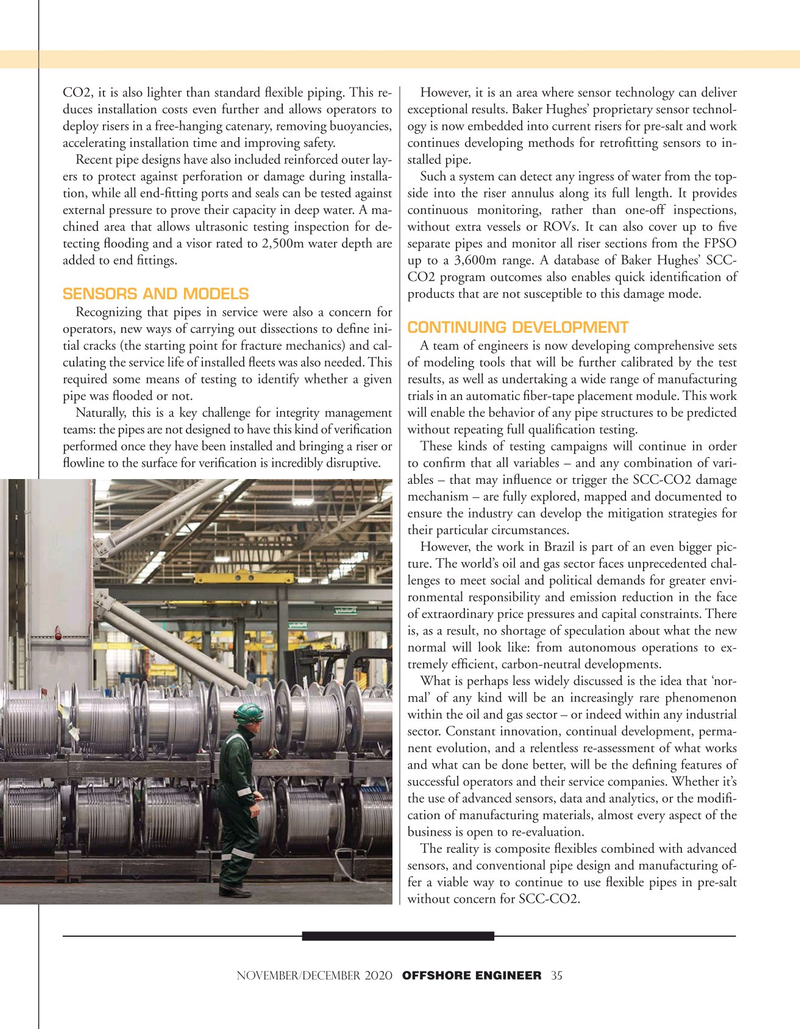
Page 35: of Offshore Engineer Magazine (Nov/Dec 2020)
Read this page in Pdf, Flash or Html5 edition of Nov/Dec 2020 Offshore Engineer Magazine
CO2, it is also lighter than standard ?exible piping. This re- However, it is an area where sensor technology can deliver duces installation costs even further and allows operators to exceptional results. Baker Hughes’ proprietary sensor technol- deploy risers in a free-hanging catenary, removing buoyancies, ogy is now embedded into current risers for pre-salt and work accelerating installation time and improving safety. continues developing methods for retro?tting sensors to in-
Recent pipe designs have also included reinforced outer lay- stalled pipe. ers to protect against perforation or damage during installa- Such a system can detect any ingress of water from the top- tion, while all end-?tting ports and seals can be tested against side into the riser annulus along its full length. It provides external pressure to prove their capacity in deep water. A ma- continuous monitoring, rather than one-off inspections, chined area that allows ultrasonic testing inspection for de- without extra vessels or ROVs. It can also cover up to ?ve tecting ?ooding and a visor rated to 2,500m water depth are separate pipes and monitor all riser sections from the FPSO added to end ?ttings. up to a 3,600m range. A database of Baker Hughes’ SCC-
CO2 program outcomes also enables quick identi?cation of products that are not susceptible to this damage mode.
SENSORS AND MODELS
Recognizing that pipes in service were also a concern for
CONTINUING DEVELOPMENT operators, new ways of carrying out dissections to de?ne ini- tial cracks (the starting point for fracture mechanics) and cal- A team of engineers is now developing comprehensive sets culating the service life of installed ?eets was also needed. This of modeling tools that will be further calibrated by the test required some means of testing to identify whether a given results, as well as undertaking a wide range of manufacturing pipe was ?ooded or not. trials in an automatic ?ber-tape placement module. This work
Naturally, this is a key challenge for integrity management will enable the behavior of any pipe structures to be predicted teams: the pipes are not designed to have this kind of veri?cation without repeating full quali?cation testing.
performed once they have been installed and bringing a riser or These kinds of testing campaigns will continue in order ?owline to the surface for veri?cation is incredibly disruptive. to con?rm that all variables – and any combination of vari- ables – that may in?uence or trigger the SCC-CO2 damage mechanism – are fully explored, mapped and documented to ensure the industry can develop the mitigation strategies for their particular circumstances.
However, the work in Brazil is part of an even bigger pic- ture. The world’s oil and gas sector faces unprecedented chal- lenges to meet social and political demands for greater envi- ronmental responsibility and emission reduction in the face of extraordinary price pressures and capital constraints. There is, as a result, no shortage of speculation about what the new normal will look like: from autonomous operations to ex- tremely ef?cient, carbon-neutral developments.
What is perhaps less widely discussed is the idea that ‘nor- mal’ of any kind will be an increasingly rare phenomenon within the oil and gas sector – or indeed within any industrial sector. Constant innovation, continual development, perma- nent evolution, and a relentless re-assessment of what works and what can be done better, will be the de?ning features of successful operators and their service companies. Whether it’s the use of advanced sensors, data and analytics, or the modi?- cation of manufacturing materials, almost every aspect of the business is open to re-evaluation.
The reality is composite ?exibles combined with advanced sensors, and conventional pipe design and manufacturing of- fer a viable way to continue to use ?exible pipes in pre-salt without concern for SCC-CO2.
NOVEMBER/DECEMBER 2020 OFFSHORE ENGINEER 35

 34
34

 36
36